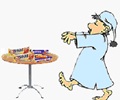Consumption of three or more energy drinks per day was associated with sleepiness on the job and sleeping ≤4 hours per night.

- Soldiers serving in recent war zones across the globe have grown particularly keen on energy drinks.
- US Military soldiers in the field were more likely to fall asleep on duty if they consumed multiple energy drinks a day.
The study by the Walter Reed Army Institute of Research, titled “Energy drink consumption and its association with sleep problems among US service members on a combat deployment,” looked at data from over 1,000 soldiers and Marines conducting operations in Afghanistan in 2010.
The research found that nearly 45 percent of deployed military personnel consumed at least one energy drink daily, while nearly 14 percent reported drinking three or more per day.
Service members who drank three or more energy drinks per day were more likely to report ≤4 hours of sleep on average per night (38.2%) than service members who drank one to two (18.4%) or zero (23.9%) energy drinks per day.
“These products generally are unregulated and can have negative side effects,” the report said. “Those who drank three or more drinks a day also were more likely to report sleep disruption related to stress and illness and were more likely to fall asleep during briefings or on guard duty.”
One of the more commonly seen brands, Rip It, is actively involved in supporting military groups like the USO and highlights its military connection in its online marketing.
Dr. Patricia Deuster, professor and director of the Consortium for Health and Military Performance at the Uniformed Services University of the Health Sciences, told the Defense Department’s science blog that “doctors don’t know what the effects of (energy drink) ingredients are in larger doses.”
Reference
- Robin L. Toblin et al., Energy Drink Consumption and Its Association with Sleep Problems Among U.S. Service Members on a Combat Deployment — Afghanistan, 2010 , Morbidity and Mortality Weekly Report, Centres for Disease Control and Prevention (2012) https://www.cdc.gov/mmwr/preview/mmwrhtml/mm6144a3.htm.
Source-Medindia













